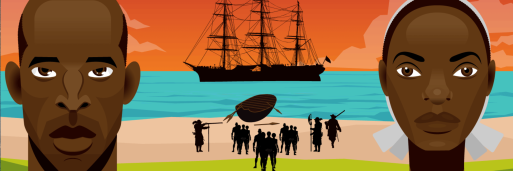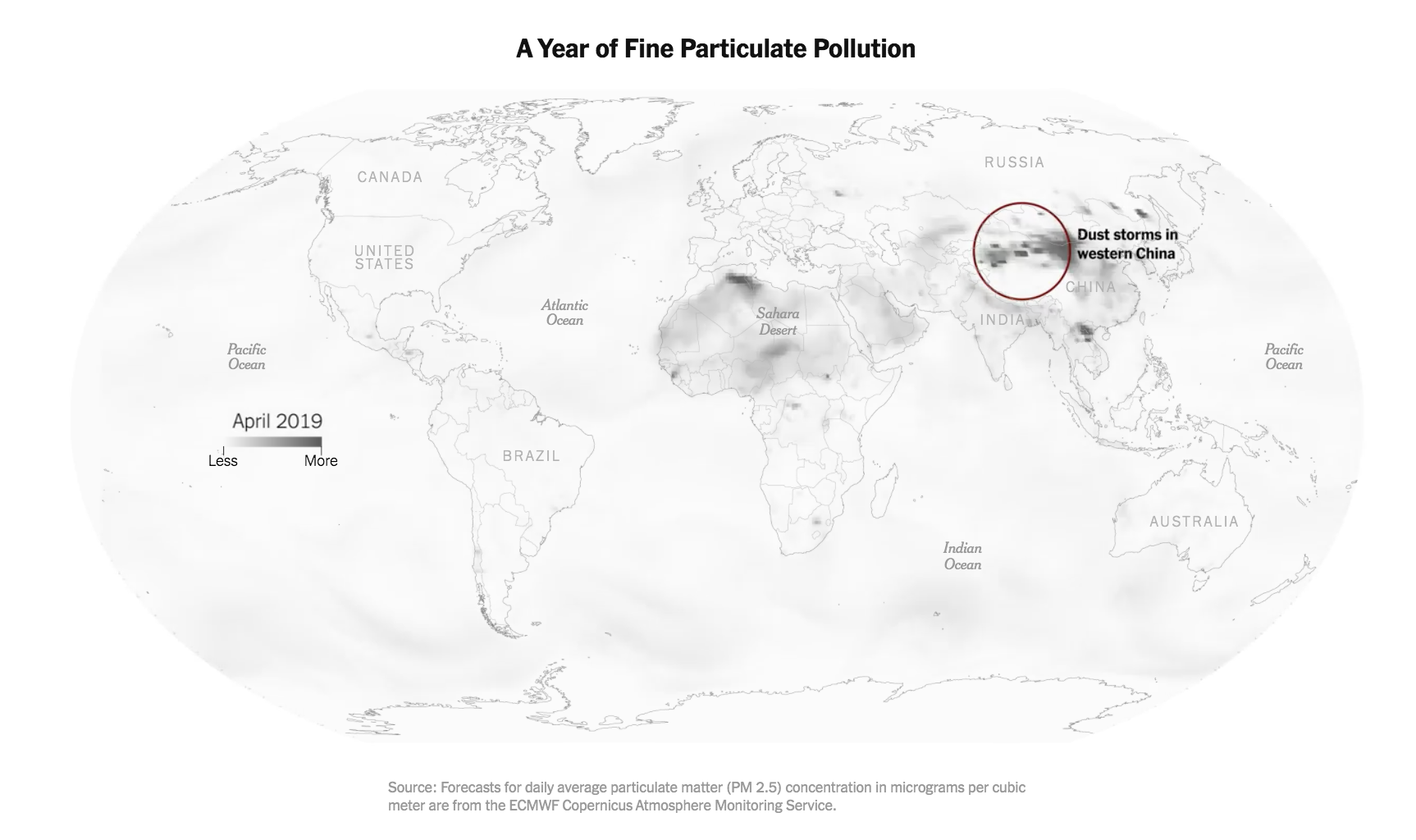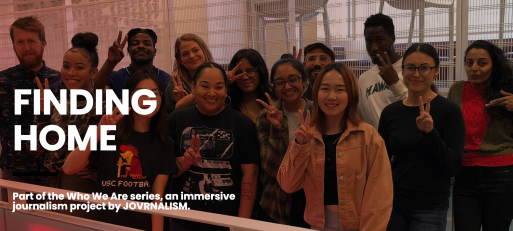The Online Journalism Awards’ Excellence in Immersive Storytelling category has a wide collection of innovative stories competing for the “Nerd Knife,” a.k.a. the shiny glass trophy.
The diverse finalists projects include pieces on air pollution, youth in foster care, Apollo 11’s 50th anniversary and the transatlantic slave trade.
We asked the OJA finalists a few questions to get their insights about their powerful projects.
Ray Soto is the Director of Emerging Tech at Gannett and USATODAY, both of which are finalists in this category. Here are his answers to our questions.
 1619: Searching For Answers | USA TODAY
1619: Searching For Answers | USA TODAY
Four hundred years ago, the San Juan Bautista sailed off Angola’s shores with 350 enslaved Africans beginning America’s history with slavery. USA TODAY’s augmented reality experience depicts what those captives would have experienced on the ship. Learn more.
- What was the biggest breakthrough/lesson learned in producing this project?
Early during the research and prototype phase of the production, we learned the ship’s design was very different than we expected. Historical documents provided to us by the Hampton History Museum’s ship expert revealed the ship that transported the first enslaved Africans, the White Lion, was much smaller than we had expected. Knowledge of the design and journey provided us with meaningful information that guided the final 3D visuals, spatial audio components, and script. - What was the biggest challenge in producing this project?
Our biggest challenge was ensuring we told the story in a way that informed without triggering strong emotions. We worked closely with historians, researchers, and writers to craft an experience that allowed users to step into a virtual environment as a means to learn. Our goal was to build an experience that felt more like an immersive museum exhibit rather than a visceral recreation of the enslaved Africans’ harrowing journey through the Middle Passage. This was a difficult story to tell as we wanted to treat the subject matter with reverence. - What is your favorite thing about this project?
We worked with many amazing people during the production of this project. Each individual provided valuable contributions to the immersive experience that helped craft the final product. We appreciated our partners’ insights and feedback throughout the development of the interactive project. 1619’s augmented reality experience would not have been possible without their help. - Any advice for a news org or an individual starting in immersive storytelling?
Be flexible and plan for revisions to your project when working on a historical experience. We learned several times throughout the development of the interactive that adjustments needed to be made to the virtual ship’s design which impacted the story’s script and audio components. We recommend incorporating a period of polish into your development schedule to accommodate changes.
 50th Anniversary: “Apollo 11: America’s Journey To The Moon” | Gannett
50th Anniversary: “Apollo 11: America’s Journey To The Moon” | Gannett
This augmented reality experience brings to life the story of the technology and mechanics behind the Apollo 11 mission to celebrate the 50th Anniversary of the historic event. Users participate in the mission by interacting with an animated breakdown of the Saturn V rocket. Learn more
- What was the biggest breakthrough/lesson learned in producing this project?
We wanted to provide an experience for both casual and hardcore space fans. The experience we crafted could not be too technical as to alienate an audience, but it still needed to be detailed enough to fascinate. Our space expert Emre Kelly provided valuable insights into his audience that guided the tone and pacing of what we built. - What was the biggest challenge in producing this project?
Our goal to develop a live augmented reality broadcast of the historic mission provided many challenges. As we started to pull together resource materials for the project, we quickly realized that we needed to understand the science behind the mission to guide the project’s animations and video companion for each event. We worked with one another to go through the 8-day mission logs down to the second to determine which events were the most relevant to the story and to our users. Once we had our animation timeline scripted, we worked with Apollo experts to ensure accuracy. - What is your favorite thing about this project?
A highlight of our project was the working with the Smithsonian to demo the interactive projects on July 20 during the 50th anniversary celebration of the Apollo 11 mission. We shared previews of the augmented reality projects and invited visitors to join us for the lunar landing live later that afternoon. At 3:17PM, the Smithsonian Castle’s lobby was filled with families with their devices watching a 3D lunar module approaching the virtual surface of the Moon in augmented reality. I’ll never forget the sound of mission beeps echoing throughout the large room. - Any advice for a news org or an individual starting in immersive storytelling?
Don’t rush the development of a project and think beyond the one-hit gimmick. Spend time understanding how best to craft your story to leverage the strengths of immersive platforms for your audience.
Karthik Patanjali is a Special Projects Editor for The New York Times focusing on new technologies, including AR/VR, 3D Web, computer vision and machine learning.
 See How the World’s Most Polluted Air Compares With Your City’s | The New York Times
See How the World’s Most Polluted Air Compares With Your City’s | The New York Times
Using augmented reality, The New York Times visualized the tiny particles that wreak havoc on human health, allowing users to compare the world’s worst pollution to their local air. Learn more
- What was the biggest breakthrough/lesson learned in producing this project?
Moving from an object based augmented reality to a native AR spatial data visualization was the biggest breakthrough. I’m very glad that our readers and the journalism community appreciated this. - What was the biggest challenge in producing this project?
Since this was the first AR experience driven by live data and geolocation that The Times published, it had a lot of technical challenges to overcome. - What is your favorite thing about this project?
This is probably the first piece that added a layer on top of the real world that made the invisible visible. It gave our readers a more personal and visceral understanding of the scale of this public health hazard. - Any advice for a news org or an individual starting in immersive storytelling?
AR doesn’t have to be overly complicated and production heavy to be successful. It sometimes helps if it isn’t.
Robert Hernandez is the professor and founder of the JOVRNALISM project based at USC Annenberg. As co-program lead for Journalism 360, he’s also the writer of this post.
Who We Are: Finding Home | USC / JOVRNALISM
Partnering with a foster care non-profit, JOVRNALISM trained youth living through the system how to tell their own stories through 360/VR and augmented reality experiences. Learn more
- What was the biggest breakthrough/lesson learned in producing this project?
While it is officially the first installment under our series name Who We Are, we have been doing collaborative, community journalism projects for a couple years now. Homeless Realities, a past OJA finalist, was a previous project and currently, this semester, we are working with members from the Domestic Abuse community. While we push ourselves with new technologies, the real break-through is successfully democratizing these emerging technologies and putting them in the hands of often underserved/underrepresented communities. They — like all communities — have powerful stories to tell and are natural storytellers. This project framework is one that works and can be repeated by others. - What was the biggest challenge in producing this project?
The biggest challenge wasn’t technical. Our biggest challenge — working with youth that was busy with school and work — was the training to get them to understand what we were making. They are natural storytellers, but this technology and the outcomes are abstract for anyone new to immersive storytelling. But once they saw a rough cut they understood what we were making together. - What is your favorite thing about this project?
There are a few things that I like about this project, ranging from a portal into a participant’s VR Art piece to the moment a social worker revisited her foster care/transitional housing. But the piece I like best is the AR experience about the teddy bear. Once we heard the two different perspectives about this bear, we knew we wanted to pursue this story somehow. I think the model, plus the audio pieces really make this a compelling moment and gets into their experiences as youth in foster care. - Any advice for a news org or an individual starting in immersive storytelling?
Don’t be intimidated. We are a small, scrappy team. While we don’t have much in terms of funding, we make up for in hustle and creativity. You can do this with little or even no funding. Start harnessing free tools and begin telling stories from your diverse community.
The winner of the award will be announced Wednesday, Oct. 14 during ONA20 Everywhere. Pour yourself a beverage, kick back and celebrate with us during the live ceremony.


